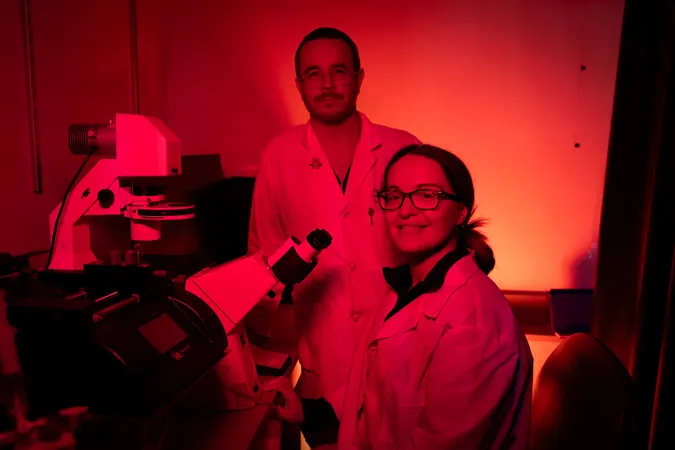
Revolutionary Research Reveals Red Light's Surprising Link to Decreased Blood Clots!
2025-01-10
Author: Ming
Groundbreaking Study Overview
In a groundbreaking study led by experts at the University of Pittsburgh School of Medicine, researchers have uncovered a fascinating connection between long-wavelength red light exposure and a significant reduction in blood clot formation, which can lead to life-threatening conditions such as heart attacks, lung damage, and strokes. This compelling research, published in the esteemed Journal of Thrombosis and Haemostasis, promises to reshape preventative health strategies for millions globally.
Insights from Dr. Elizabeth Andraska
Lead author Dr. Elizabeth Andraska, a prominent surgeon and assistant professor at Pitt, explained, "The light we’re exposed to can transform our biological processes and overall health." The implications are profound—if further validated through clinical trials, this discovery could pave the way for an affordable therapy that dramatically decreases the incidence of blood clots—one of the leading preventable death causes worldwide.
Research Methodology
Historical studies have long established a link between various wavelengths of light and health outcomes, indicating that our natural rhythms greatly influence bodily functions. Dr. Andraska and her team examined whether different light exposures might also affect blood clot formation, particularly during times of heightened risk for vascular incidents, often occurring in the early morning.
Experimental Findings with Mice
To investigate this theory, the research team conducted an experiment with mice, exposing them to 12-hour cycles of red, blue, or white light followed by darkness. Remarkably, the results revealed that mice subjected to red light experienced nearly five times fewer blood clots than their peers exposed to blue or white light. Importantly, other vital signs such as activity levels, sleep patterns, and body temperature remained consistent across all groups.
Analysis of Cataract Surgery Patients
Further validating this light-clot connection, the researchers analyzed data from over 10,000 patients who underwent cataract surgeries. They discovered that cancer patients who wore blue light-filtering lenses had a significantly lower risk of developing blood clots compared to those using conventional lenses—an important finding, given that cancer patients face a ninefold risk of clotting issues.
Future Directions in Research
Senior author Dr. Matthew Neal, a trauma surgeon at UPMC, emphasized the significance of understanding the biological mechanisms behind these astonishing observations, stating, "Our next steps are to investigate the underlying processes and explore whether further red light exposure can mitigate clot risks in vulnerable populations."
Role of the Optic Pathway
The researchers believe that the optic pathway itself plays a crucial role in how light affects the body. Intriguingly, light exposure had no noticeable effect on blood clotting in blind mice, suggesting that visual perception is key to this phenomenon. Additionally, those subjected to red light displayed reduced inflammation markers and lower levels of neutrophil extracellular traps—structures that can ensnare pathogens but also contribute to clot formation.
Implications for Health
With red light exposure linked to increased fatty acid production—a known inhibitor of platelet activation—the research suggests a natural route to promote healthy blood flow. As per the team's findings, strategically harnessing red light could revolutionize treatment approaches and potentially inspire the development of more effective medication options.
Next Steps and Innovations
As the team prepares for upcoming clinical trials, they are taking innovative steps by designing red light goggles to regulate exposure for participating individuals, while also assessing populations that could gain the most benefits from this therapy.
Conclusion
Stay tuned! This pioneering study could very well change the landscape of vascular health and save countless lives around the globe.

 Brasil (PT)
Brasil (PT)
 Canada (EN)
Canada (EN)
 Chile (ES)
Chile (ES)
 Česko (CS)
Česko (CS)
 대한민국 (KO)
대한민국 (KO)
 España (ES)
España (ES)
 France (FR)
France (FR)
 Hong Kong (EN)
Hong Kong (EN)
 Italia (IT)
Italia (IT)
 日本 (JA)
日本 (JA)
 Magyarország (HU)
Magyarország (HU)
 Norge (NO)
Norge (NO)
 Polska (PL)
Polska (PL)
 Schweiz (DE)
Schweiz (DE)
 Singapore (EN)
Singapore (EN)
 Sverige (SV)
Sverige (SV)
 Suomi (FI)
Suomi (FI)
 Türkiye (TR)
Türkiye (TR)
 الإمارات العربية المتحدة (AR)
الإمارات العربية المتحدة (AR)